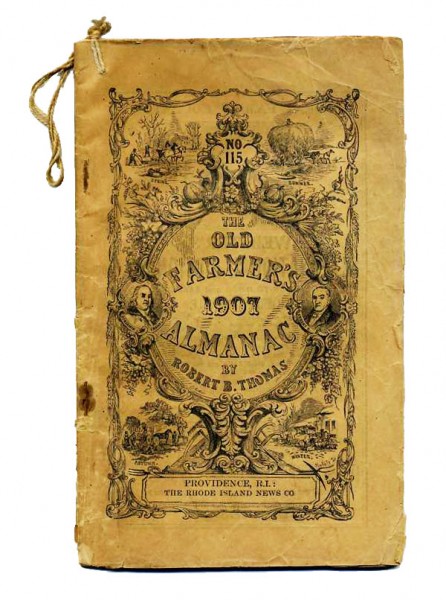Proto-TP

The Old Farmer’s Almanac, pictured above, comes out on the second Tuesday in September and has every year since 1792. The manual, first and foremost, is a guide to the weather, forecasting each day of the year to come. It also reports on tides, moon phases, and the like — a lot of stuff designed to help farmers maximize their crop yields and livestock returns. By and large, the Almanac has remained the same over its 200-plus year history, although there have been exceptions. From 1943 to 1945, the editors had to drop the weather forecasts from the guide (in favor of sharing just the indicators used to make those predictions), as the U.S. military did not want that information shared with the enemy during World War II. And see that small hole in the upper left corner? Sometime in the 1990s, to save on printing costs, they stopped doing that. Temporarily, at least.
You can blame tradition and toilet paper for that.
Toilet paper, as recounted earlier in these pages (see the bonus fact at that link), was first produced commercially in the United States in 1857. While it was well-received nearly immediately, the idea of paying for an item to do that job wasn’t all that popular. For decades, many outhouse-goers (and pardon the double entendre there) opted against forking over their hard-earned cash in order to purchase paper designed for your bum. Instead, they’d use the paper they already had. The Old Farmer’s Almanac worked beautifully for this. First, it already had a hole punched through it — the publisher wanted it to be hung in a place where it would be easily accessible (and not get lost). So it was easy to hang in the outhouse. And second, yesterday’s weather report isn’t all that valuable anyway, so why not tear it out of the book and get yourself clean? It was a win-win.

As seen above, running a cord through the hole persisted until at least 1907 (and likely much longer) — that’s fifty years after the invention of commercially available TP. But when toilet paper caught on, the need for the hole became less and less. According to the Quad-City Times, in the 1990s, the publisher realized that the hole had served its purpose. No longer punching the hole meant a cost-savings of roughly $40,000. Ending the tradition seemed like a no-brainer — but readers objected, citing the hole as part of the Almanac’s brand. The hole returned a few years later.
Amazingly, this isn’t the first, or only time that a publication’s secondary use as toilet paper led to consumer complaints. In 1893, the Sears Roebuck company (now just Sears) began its mail order business by sending out catalogues to consumers across the United States. After leafing through it, many recipients re-purposed the often hefty catalogues, turning its pages into free toilet paper. According to the Straight Dope, the catalogue’s popularity may even have been driven, in part, by this unintended use. But when Sears went to a color catalogue with a sheen finish, many were upset, as the paper quality was no longer acceptable for outhouse duties.
Bonus Fact: In 2012, Iran barred the import of certain “luxury goods,” in the words of Bloomberg Businessweek, in hopes of curtailing the flight of money to destinations outside its borders. But their definition of “luxury goods” is far more extensive than that of most others, evidenced by the fact that toilet paper makes the list.
From the Archives: A Spy’s Doody: How depriving Soviets of toilet paper helped Western intelligence gather information during the Cold War.
Related: The 2014 version of the Old Farmer’s Almanac. If you click through, you’ll see that there’s a hole in a top corner. If you buy it, please use it as reading material.
